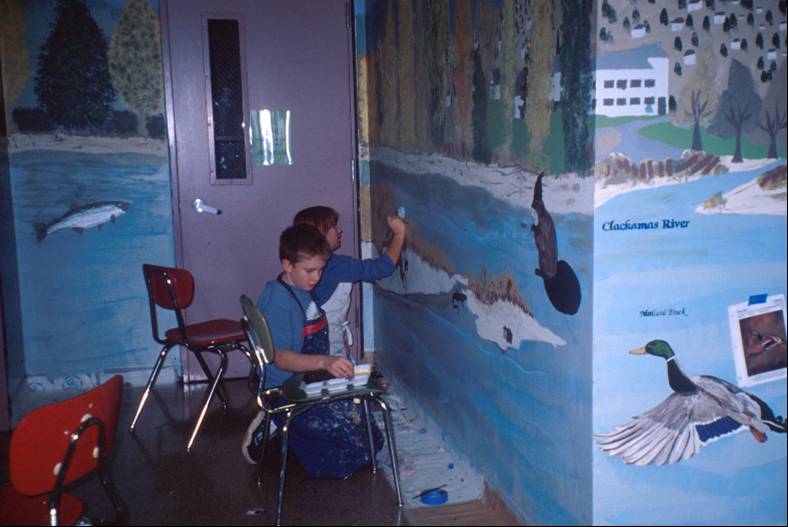| COOPERATIVE CONSERVATION CASE STUDY | | Metropolitan Greenspaces Program | | Conserving urban greenspaces for wildlife and people | | Location: Far | | Project Summary: This program supports environmental education, habitat restoration and protection, environmental planning, and ecological studies throughout an urban greenspaces system. |
|  | | Students paint murals throughout their school to celebrate local greenspaces and the fish and wildlife that live there.
(Photo: Jennifer Thompson, U.S. Fish and Wildlife Service) |
|
Resource Challenge
In the late 1980’s, the Portland Audubon Society and their partners put together a proposal to create a "Metropolitan Wildlife Refuge System" throughout the four-county, bi-state Portland, Oregon/Vancouver, Washington region to help sustain the area’s natural heritage and connect people with nature. In response to their efforts to solicit Federal support through the U.S. Fish and Wildlife Service (Service), Congress and the President approved fiscal year 1991 funding to initiate the Metropolitan Greenspaces Program that was used to help launch and sustain their efforts through 2004. A variety of innovative, cost effective and partnership-based strategies were used in the areas of environmental education, public outreach, fish and wildlife habitat restoration, environmental planning, greenspaces protection and management, and urban ecological research. The Service shared administrative responsibilities with Metro, the only directly elected regional government in the
U.S. The program supported the Service’s fish and wildlife conservation mission, Metro’s roles in environmental education, land use planning and management of an extensive network of regional parks and open spaces, and the work of numerous local partners engaged in conservation. Federal involvement was also used to promote bi-state partnerships between ecologically-connected, but politically-separated metropolitan areas. Although it no longer receives Federal support, the Metropolitan Greenspaces Program provides a proven case study for a successful conservation partnership between the Service and the local community that could be used as a model for similar efforts in the future. In addition, the on-going work of local partners continues to build off of past successes.
| Examples of Key Partners Metro Regional Government, the Audubon Society of Portland, the U.S. Fish and Wildlife Service and numerous agencies, cities, counties, soil and water conservation districts, schools, non-profit organizations, watershed councils, businesses, citizens and others. |
| Results and Accomplishments Federal allocations of approximately $300,000 annually from 1991-2004: a) supported greenspaces planning that led to citizen passage of a $135.6 million bond measure used to acquire more than 8,000 acres of significant fish and wildlife habitats, parks and trails, b) provided over $2.8 million for more than 300 habitat restoration, natural resource conservation and environmental education grant projects that leveraged over 3:1 in partner contributions, c) funded publications, events and resources for environmental education, outreach, and technical support, and d) led to mutually beneficial and collaborative partnerships between the Service, Metro and others to accomplish a wide variety of proactive conservation projects. |
|
Innovation/Highlight Grassroots vision and leadership from the local conservation community was used to build partnerships between the public, private, and non-profit sectors. Remarkable on-the-ground achievements conserving greenspaces within the urbanized landscape have left an indelible mark that contributes to the identity of the Portland, Oregon/Vancouver, Washington metropolitan region as a thriving place to live, offering citizens a high quality of life and daily exposure to nature. In addition, those working in the area are helping to expand our knowledge about the social and ecological roles urban areas can and need to play in broader natural resource conservation efforts to protect the nation’s biodiversity and maintain a healthy environment. They have initiated the Urban Ecological Resource Consortium to promote further discussion and research about these topics. |
| |
 Land Conservation
Land Conservation Conservation
Conservation Arkansas
Arkansas California
California Colorado
Colorado Houston
Houston Idaho
Idaho Louisiana
Louisiana Maine
Maine Mississippi
Mississippi Habitat
Habitat
 Land Conservation
Land Conservation Conservation
Conservation Arkansas
Arkansas California
California Colorado
Colorado Houston
Houston Idaho
Idaho Louisiana
Louisiana Maine
Maine Mississippi
Mississippi Habitat
Habitat